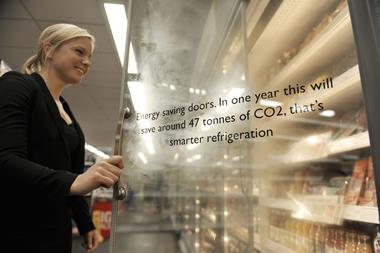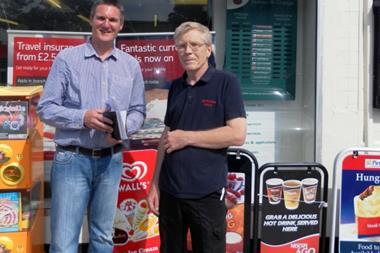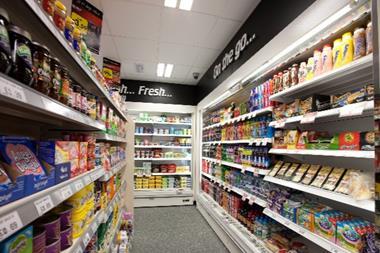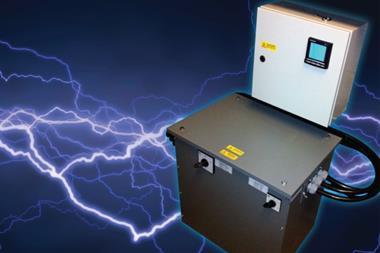Improvements to LED lighting mean previous arguments against the technology have been shattered. Here’s why they need a second glance
Dull, blue and expensive. These are the three most common misconceptions about the UK LED lighting market. Read them and then sweep them aside, because now is the time to start benefiting from the array of recent developments which are contributing to the LED market’s blinding growth.
The past 12 months have seen an explosion in the diversity of LEDs in size, shape, light output and colour spectrum, and the use of LEDs in lighting is growing at 44% year on year, with a 9.8% growth for LEDs overall.
“The LED lighting market is huge and increasing constantly,” explains Mark Crabtree, sales director of UK electricity reduction company Enviroglow.
Crabtree says that the right light can now be found to suit almost any store and need, doing away with any previous misgivings about their use. “In our experience, we find retailers believe that LED light is cold in colour and feel. But with the increased colour spectrum of LEDs available now, this is not the case,” Crabtree asserts.
“Store owners can also think that the light levels from LEDs, given the much lower wattage, will be poor. This was the case with early generations of LED lights which were perfect for decorative and marker lighting, but if used to light a room the entire ceiling would need to be studded with them to be able to see well enough to avoid bumping into things. The latest generations raise the stakes. Now, for example, a few downlights can be used to achieve the equivalent of 25w-100w illumination. This means that LEDs are more than worthy of real consideration for general retail lighting,” Crabtree continues.
Understanding colour temperature
LEDs are available in different colour renditions, or burning temperatures, measured in Kelvin.
Lower Kelvin numbers mean that the light appears more yellow higher Kelvin numbers mean the light is whiter or bluer.
Imagine the light given off from the sun at different times of the day. At midday the light is at its brightest and whitest. At sunrise and sunset the light takes a yellower or more reddish tint.
• Warm White: typically 2,600-3,500 Kelvin
• Natural White: 4,000-4,500 Kelvin
• Daylight White: 5,000-5,500 Kelvin
• Commercial or Cool White: above 6,000 Kelvin
Efficiency has also come on in leaps and bounds, with good quality LEDs now using about five times less power than a 20w halogen bulb, and all that with a lifespan of up to 50 times longer.
This enviable longevity also means that the lights require far less maintenance, and ‘re-tubing’ costs are effectively eliminated.
And as a growing number of studies are now demonstrating, the improved quality of lighting offered by LEDs can have a valuable impact on sales. Well-designed LED lighting can create a more pleasant in-store environment and enhance the look of merchandise, potentially boosting sales. The recent trial by lighting specialist Philips just goes to show what a difference well chosen lighting can have on how appealing food can look, and how customers respond to it.
Driving down costs
The cost of installation has traditionally functioned as another barrier to take-up. However, noteworthy improvements have also been made here of late, too.
The growth in demand and on-going investment in developments have driven costs down in recent years, with continued price reductions of about 10% a year expected until at least 2015.
Paul Cheema has just had LED lighting installed in his new Kwiksave-branded store in Chelmsley Wood on the outskirts of Birmingham with cost-saving his main goal. “LEDs still cost about a third more than conventional lighting, but at the end of the day you are shaving two-thirds off your energy bill for lighting,” he explains.
sales success
Get the right shade
A recent trial by lighting specialist Philips showed that intelligent LED lighting could have a measurable effect on fresh produce sales. Sales of tomatoes, lettuce, bananas and vegetables rose by 4.7% following the installation of its LED lights specifically designed to enhance different types of fresh foods.
For fresh fruit and veg it recommends using luminaires in LED Authentic White or LED Champagne. When it comes to cheese, LEDs with more yellow tones are advised, and for bread, lighting with white-yellow or red-brown tones will make it look more appetising. For pastries, a cool white light will enhance the appearance. As for meat, a warm white light with a subtle red glow will display it at its best.
And let’s not forget that energy prices are only heading in one direction - upwards. Last month saw four of the UK’s major energy suppliers hike prices ahead of winter, and you can be sure that other providers will soon follow suit. “As time goes by, with purchase costs reducing and energy costs increasing, the balance of the cost versus saving equation is only moving in one direction,” Crabtree adds. “Electricity prices will continue to rise, as energy-saving solution costs will continue to fall.”
And if you can’t, or don’t wish to shell out for the cost of installation in one go, the good news is that most of the UK’s key suppliers offer a range of leasing agreements to pay for the work.
Remember that financing for energy efficiencies is also available from companies such as The Carbon Trust. You may also be eligible for Green Deal financing, which allows you to pay for the work via the savings made on your energy bill. Check out www.gov.uk/green-deal-energy-saving-measures to find out more.
If you have a good relationship with your electrician you could even think about having the work carried out in stages, as Premier retailer Dennis Williams of Broadway Convenience Stores in Edinburgh, is doing.
Dennis is introducing LED lighting bit by bit, starting with the rear of his store, where he has just invested in augmenting his fresh produce range.
“I’ve got five in already, and I’m planning to buy in a couple a week, rather than paying for one big outlay. I have a good agreement with my electrician, who has them in stock, which allows me to do this,” he explains.
Should you wish to take this approach it’s a good idea to determine which lamps will have the best return on your investment and install these first. Replacing lights that are on more hours a day will have greater savings and replacing those that are harder to get to will save you time as LEDs need changing less often.
Having a good relationship with your electrician or a reputable supplier will also ensure that you don’t fall into the ‘bad LED’ trap.
The internet is awash with companies claiming to make and install LED lighting and, unfortunately, not all are reputable, with cheap products producing poor results.
Says Andrew Fletcher, managing director of Carbon Control: “There are many different qualities of LED and it really depends on who you buy from. There is a lot of rubbish available on the internet. The quality of the chip and the silicone within the LED is really important. ‘Bad’ LEDs, for example, will produce a more blue glow, when what you want is a ‘warm white’ colour.”
Crabtree agrees. “Any guarantee is only as good as the company behind it,” he says. “If the technology that runs the light is cheap, you will very likely not get the savings or, worse, the units will ultimately fail,” he adds.
Paul used Swindon lighting specialist Microlights for his LED installation. “Lighting a retail store is so different from lighting a bar or car showroom, and getting the lighting levels just right is key to creating that warm, welcoming glow, as opposed to a chilly blue.”
Fletcher also recommends first talking to a known or reputable electrician before having any work carried out. “Electrical wholesalers have really stepped up their efforts to educate the industry of late, and a good electrician should know what’s what,” he adds.
If you need help finding a suitable supplier and installer, check out the Carbon Trust’s Directory of Accredited Businesses at www.carbontrust.com/resources/tools/green-business-directory.
saving money
Cut your lighting bills
Lighting plays a crucial role for retailers, attracting custom and showcasing merchandise to its best effect. That means that, unlike some businesses, retailers can’t simply turn off the lights when they’re not needed to save energy. Lighting can represent up to 30% of energy use in convenience stores.
However, there are simple measures that can be taken to reduce energy consumption without impacting the effectiveness of in-store lighting.
One easy step retailers can take is to replace fluorescent lighting with more modern LED lamps to instantly cut lighting energy costs by 50%. In many cases, this means simply swapping the tubing or bulbs for LEDs, rather than installing new fittings.
Installing controls that activate lights only when required could also return significant savings. For example, controls can be set to turn lights on when a customer is in close proximity, or to respond to changes in natural light levels by increasing or decreasing accordingly. The cost of installing this type of equipment has dramatically reduced as energy-saving technology has become more popular, so for a small investment retailers can reduce energy consumption and ensure that savings are felt on the bottom line.
With lighting playing such an important role for convenience stores, it is essential that the right approach is taken. Npower works closely with retailers to help them identify the key areas where savings can be made in their business and can show how to implement the right measures to achieve them. In fact, these measures often improve lighting and create savings at the same time.
Want to reduce your costs? To find out how npower could help your business save energy, visit www.npower.com/business/save-energy
Case Study
Out with the old: the advantages of switching to LED

Robin Hood Service Station (Spar) in Chatham, Kent, has halved its lighting bills following the installation of in-store LED lighting.
The project, managed by MHA Lighting, saw traditional fluorescents on the shop floor and food preparation areas replaced with a selection of the company’s TiLite 40/700 fittings.
Says store owner Steve Fox: “I was keen to utilise LED lighting because of the huge energy savings that can be achieved - not to mention the fact that we were constantly up ladders replacing bulbs. This just wasn’t practical and was very time-consuming.”
The move has reduced annual lighting energy consumption from 39,033kW/h (average annual cost of £3,093) to 20,364kW/h. Average annual energy bills have been reduced to £2,036.
The new lighting system utilises 120 lumen LEDs and is extremely low maintenance, running for 60,000 hours of continuous use, ideal for the store’s 16-hour-a-day, seven-days-a-week operation, as the lights will not need replacing for 11 years.
Steve adds: “MHA’s LED lighting has breathed new life into the store not only increasing sales, safety and security for our customers, but significantly reducing our energy costs, which for me is essential.”
He says customers have noticed the improved lighting, adding: “I am particularly impressed with how uniformly distributed the light is, especially on the produce.”
An additional benefit comes as the sealed units do not attract dust or insects, while the lack of heat given off also means that produce stays fresher for longer. Consequently, the store’s chillers and air conditioning also don’t need to work as hard, saving further energy.






















No comments yet